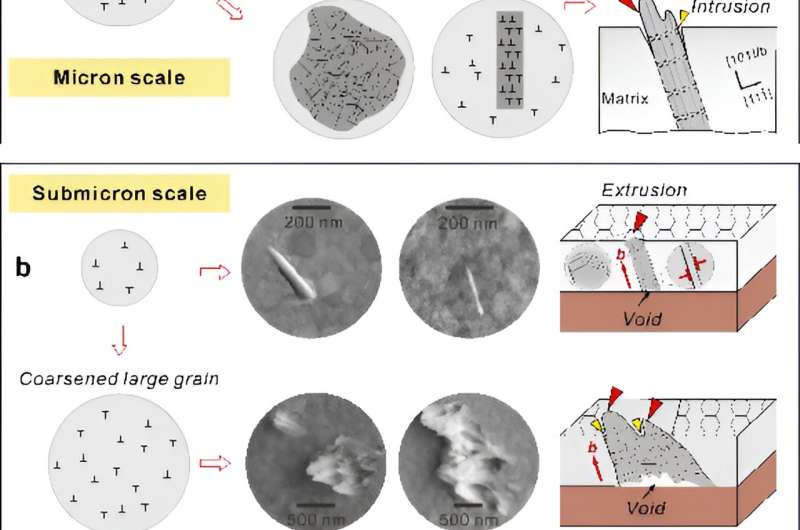This article has been reviewed according to Science X's editorial process and policies. Editors have highlighted the following attributes while ensuring the content's credibility:
fact-checked
peer-reviewed publication
trusted source
proofread
Scientists unveil vacancy-assisted fatigue damage mechanism at small scales

Classical theories of fatigue damage in bulk metals have been extensively studied, but little is known about the fundamental fatigue mechanisms at submicron and nanometer scales, where dislocation pattern formation is completely inhibited.
Prof. Zhang Guangping and his research team from the Institute of Metal Research (IMR) of the Chinese Academy of Sciences have revealed the vacancy-dominated fatigue mechanism at smaller scales through quantitative analysis of fatigue damage.
Their work was published in Acta Materialia.
In this study, the researchers found that although no typical persistent slip band-like dislocation patterns could be found in Au films with h=930 nm ~ 90 nm, severe fatigue extrusion/intrusion behaviors can also be observed in these thin films.
Unexpectedly, the relative extrusion height increases with decreasing the film thickness, and it is even thousands of times larger than that of bulk-scale single and polycrystals, but the fatigue resistance or fatigue life of the small-scale thin films is higher than that of the bulk-scale ones.
Combining the detailed characterization of fatigue damage and vacancy defects with theoretical calculations, it is shown that the continuous generation and migration of vacancies is crucial for the shape of extrusion/intrusions and kinetics of their growth at submicron and even nanometer scales.
The discovery of the vacancy-dominated fatigue mechanism at small scales helps to expand our understanding of metal fatigue mechanisms to submicron and even nanometer scales.
The researchers also suggested an innovative interface engineering approach by modulating the vacancy behavior for fatigue-tolerant materials, including composite current collectors for new energy batteries, flexible electronic devices, and mechanical components in microelectromechanical systems.
More information: Honglei Chen et al, More severe surface relief but stronger fatigue resistance at small scales: Vacancy-assisted fatigue damage mechanism, Acta Materialia (2024). DOI: 10.1016/j.actamat.2024.120028
Journal information: Acta Materialia
Provided by Chinese Academy of Sciences





















